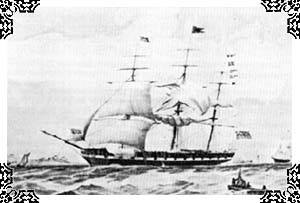








While these artifacts are hard to authenticate, there are few long-standing homes in Cavendish, P.E.I . that do not lay claim to some remnant of the ship-wrecked vessel, the Marco Polo. Its story has spread just as widely as its relics. The ship was built in 1851 by Smith Shipbuilding of Saint John, New Brunswick. The vessel took its name from the Italian explorer, whose principal claim to greatness was the new trade routes he staked out between Europe and China. Appropriately enough, the ship that bore his name also won accolades for its Pacific voyages. After completing a round trip between England and Australia in a scant 11 months and 21 days, it won the undisputed title of the fastest ship afloat in the world. Banking on this recognition, its owners sold it to the Black Bell line, where it became one of the most famous passenger ships of its day.
Enduring a regular battering from the seas, however, wooden ships could not stay fast or glamorous forever. As it aged, the Marco Polo followed a predictable fall from grace. It was refitted and used in the Australian immigrant trade. By 1880, it had been condemned and was purchased by a Norwegian company to export Canadian timber.
While the Marco Polo may have been carrying
fresh  lumber,
its own wooden hull had seen its better days. In 1883,
the ship was heading back for England and, just off the
coast of Prince Edward Island, its seams began to pour
water. The crew began to jettison cargo, but in the
process, had to saw in half some of the ship's supporting
girders. The move backfired, as the gale force winds
began loosening the ship's tired hull even more. Finally,
in an effort to salvage at least their own lives, the
captain and crew ran the ship aground at Cavendish beach.
lumber,
its own wooden hull had seen its better days. In 1883,
the ship was heading back for England and, just off the
coast of Prince Edward Island, its seams began to pour
water. The crew began to jettison cargo, but in the
process, had to saw in half some of the ship's supporting
girders. The move backfired, as the gale force winds
began loosening the ship's tired hull even more. Finally,
in an effort to salvage at least their own lives, the
captain and crew ran the ship aground at Cavendish beach.
The Marco Polo's string of bad luck was by no means over. A salvage company was hired to strip the grounded vessel, but when another intense storm rolled in, they found themselves stranded on the unstable wreck. Captain Macleod of French River came through the tossing waters to rescue the men, and after one failed attempt, managed to save all but one. The captain and his crew received gold watches for their acts of courage on behalf of their fellow seamen.
 While this salvage
attempt nearly ended in disaster, many pieces of the
Marco Polo still managed to make their way ashore and
into the hands of local collectors, eager to have some
remembrance of the spectacular wreck. One of the most
impressive features of the ship were its twin
figureheads, depicting its explorer namesake. For years,
one of these elaborate wooden carvings hung in a barn in
Long River, until its historic significance was finally
recognized and it was moved to a Saint John museum. There
is some speculation that if all of the so-called parts of
the Marco Polo were assembled, it would make two of the
original. But, on the Island as elsewhere, the romance of
shipwrecks is as much about legends as facts.
While this salvage
attempt nearly ended in disaster, many pieces of the
Marco Polo still managed to make their way ashore and
into the hands of local collectors, eager to have some
remembrance of the spectacular wreck. One of the most
impressive features of the ship were its twin
figureheads, depicting its explorer namesake. For years,
one of these elaborate wooden carvings hung in a barn in
Long River, until its historic significance was finally
recognized and it was moved to a Saint John museum. There
is some speculation that if all of the so-called parts of
the Marco Polo were assembled, it would make two of the
original. But, on the Island as elsewhere, the romance of
shipwrecks is as much about legends as facts.